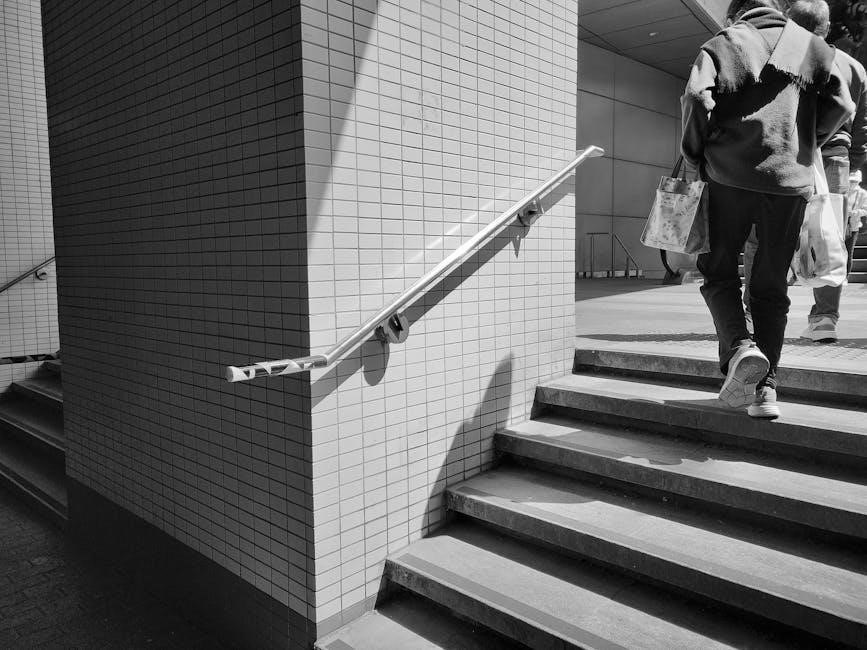exterior stairs code requirements pdf
Exterior stairs code requirements ensure safety and accessibility, following international building codes and local regulations, providing guidelines for construction and maintenance of outdoor stairways and landings effectively always.
Overview of Exterior Stairs Code
Exterior stairs code requirements are outlined in various building codes and regulations, including the International Building Code and the International Residential Code. These codes provide guidelines for the construction and maintenance of outdoor stairways and landings, ensuring safety and accessibility for users. The codes cover aspects such as stairway design, materials, and load calculations, as well as requirements for handrails, guardrails, and landing dimensions. Additionally, local building codes and regulations may also apply, and it is essential to consult with local authorities to ensure compliance. The exterior stairs code requirements are designed to protect users from hazards such as falls, fires, and structural collapses, and to provide a safe means of egress in emergency situations. By following these codes and regulations, builders and property owners can ensure that their exterior stairways are safe, accessible, and compliant with relevant laws and standards. Overall, the exterior stairs code provides a framework for designing and constructing safe and accessible outdoor stairways.
Exterior Stair Railing Code Requirements
Exterior stair railings must be at least 42 inches high, with balusters spaced no more than 4 inches apart, ensuring user safety always effectively;
Load Calculation for Exterior Stairs
The load calculation for exterior stairs is a critical aspect of ensuring the safety and structural integrity of the stairs. According to the international building codes, exterior stairs must be designed to support a load of not more than forty persons per floor above the street below. This load calculation takes into account the weight of the occupants, as well as any additional loads that may be imposed on the stairs, such as snow or ice. The load calculation is typically performed by a structural engineer or architect, who will use specialized software and techniques to determine the required load-bearing capacity of the stairs. The results of! the load calculation will inform the design and construction of the stairs, including the selection of materials and the spacing of supports. By performing a thorough load calculation, builders can ensure that their exterior stairs are safe and compliant with relevant building codes.

Exterior Stair Landing Requirements
Exterior stair landings require specific dimensions and materials for safety and accessibility always following local building codes and regulations effectively.
Protection of Exterior Stairs
Protection of exterior stairs is crucial to ensure safety and prevent accidents. According to the codes, exterior stairs should be protected along their outer sides as required for exterior corridors. This includes providing a roof over the stairs and ensuring that the stairs are not enclosed unless the space is completely enclosed in 1-hour fire-resistance-rated construction. The New York City Building Code 2022 also states that there shall not be enclosed usable space under exterior exit stairways unless the space is completely enclosed in 1-hour fire-resistance-rated construction. Additionally, the stairs should be designed to withstand various weather conditions and potential hazards such as earthquakes and floods. The protection of exterior stairs also involves regular maintenance and inspections to identify any potential hazards or defects. By providing proper protection, exterior stairs can be safe and accessible for everyone. The codes provide guidelines for the protection of exterior stairs.

Materials for Exterior Stairs
Exterior stairs require durable materials like wood, metal, and concrete to ensure safety and longevity always effectively.
Noncombustible Materials for Exterior Stairs
Noncombustible materials are essential for exterior stairs to prevent fire hazards and ensure safety. According to the California Fire Code 2022, exterior stairways can be made of noncombustible materials or wood with a nominal thickness of not less than 2-inch. The use of noncombustible materials such as metal, concrete, and glass provides a high level of fire resistance and durability. These materials can withstand various environmental conditions and are ideal for exterior stair construction. The International Building Code also emphasizes the importance of using noncombustible materials for exterior stairs, especially in high-occupancy buildings. By using noncombustible materials, building owners can reduce the risk of fire and ensure compliance with building codes and regulations. Overall, noncombustible materials are a crucial aspect of exterior stair design and construction, providing a safe and durable solution for building occupants.

International Building Codes for Exterior Stairs
International codes provide guidelines for exterior stair construction, ensuring safety and accessibility, with specific requirements for materials and design, always following local regulations effectively online.
Exterior Stairs as Part of Egress
Exterior stairs play a crucial role in the means of egress, providing a safe and accessible route for occupants to exit a building in case of an emergency. According to the US Access Board, exterior stairs that are part of a means of egress must comply with specific requirements, including those related to tread depth, riser height, and handrail design. The International Building Code also provides guidelines for exterior stair construction, including requirements for landing size, guardrail height, and stairway width. Furthermore, exterior stairs must be designed to accommodate the expected occupant load, with a minimum width of 44 inches for stairs serving an occupant load of 50 or more. By following these guidelines, exterior stairs can be designed to provide a safe and efficient means of egress, while also complying with relevant building codes and regulations. This ensures a safe exit for occupants in emergency situations.

ADA Requirements for Exterior Stairs
ADA requirements ensure exterior stairs are accessible, with guidelines for handrail height, tread depth, and landing size, promoting safety and equality for all users always effectively.
US Access Board Guidelines for Exterior Stairs
The US Access Board provides guidelines for exterior stairs, focusing on accessibility and safety, with requirements for handrails, tread depth, and landing size, to ensure equal access for all users.
The guidelines also address the importance of maintaining exterior stairs, including regular inspections and repairs, to prevent accidents and ensure compliance with accessibility standards.
Additionally, the US Access Board guidelines for exterior stairs emphasize the need for clear navigation and wayfinding, including signage and visual cues, to facilitate safe and independent use by people with disabilities.
Overall, the US Access Board guidelines for exterior stairs play a crucial role in promoting accessibility and safety in outdoor stairways, and are an essential resource for architects, builders, and property owners.
The guidelines are regularly updated to reflect changes in technology and design, and are available online for easy reference and implementation.
Local Building Codes for Exterior Stairs
Local jurisdictions enforce specific codes and regulations for exterior stairs, varying by region and municipality, requiring compliance with safety standards and accessibility guidelines always and effectively.
New York City Building Code for Exterior Stairs
The New York City Building Code provides specific guidelines for exterior stairs, including requirements for stairway construction, landings, and railings. According to the code, exterior stairs must be constructed to withstand various loads and stresses, and must be designed to provide safe and accessible egress. The code also requires that exterior stairs be protected from the elements and that they be maintained in good condition. Additionally, the code specifies requirements for the enclosure of space under exterior stairways, including the use of fire-resistance-rated materials. Overall, the New York City Building Code for exterior stairs is designed to ensure the safety and accessibility of outdoor stairways in the city. The code is enforced by local building authorities, and compliance is required for all new and existing exterior stairs. This includes residential and commercial buildings, and applies to all types of exterior stairways.
